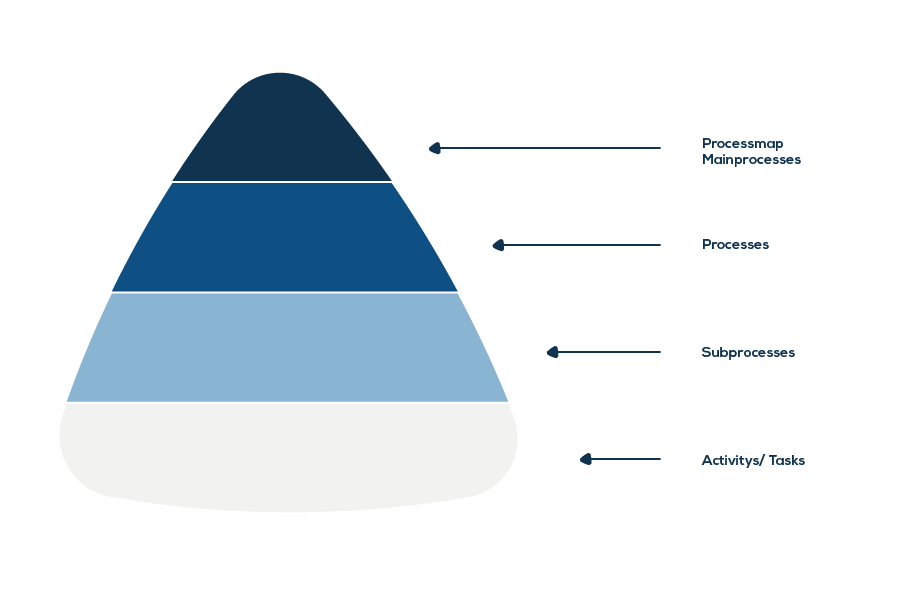Process modeling as the basis for the digitalization of field service management processes
This is what the article contains
- What is process modeling and why do we deal with processes at all?
- What is the purpose of process modeling and what models exist?
- What does process modeling have to do with digitizing field service management processes?
- Why should you model your processes?
Who does what, when and with which tools? Efficient corporate management requires the constant evaluation, revision and optimization of business processes - both internally and externally. Only in this way companies succeed in remaining competitive even in the digital age. In particular, the constant new and further development of modern information and communication systems, as well as the wave of digitization in the wake of the COVID pandemic, demand a rethinking: How do companies manage to exploit the potential of digital transformation for their field service management and thus meet the growing demands of the market? This is precisely where process modeling comes in.
1 What is Business Process Modeling (BPM)?
Business Process Modeling (BPM) enables companies to simplify mostly complex business processes. In the first instance, an inventory of the current state is made in order to define the what, who and how of the company. The goal of process modeling is to analyze and optimize process flows and automate them in the course of digital transformation. Significantly lower error rates and throughput times not only ensure higher quality, but also reduced costs.
Consequently, BPM refers to "changing the structure or sequence of individual steps or even entire processes" in order to adapt the company to new conditions such as digitalization.1
Thus, process modeling can usually be assigned to at least one of the following areas:
- Control
- Organization
- Information
- Security

1.1 What is a Business Process Model?
The processes identified in the company are represented graphically in a so-called process model to ensure a better understanding. The initial focus is on identifying individual sub-processes and thus filtering out dependencies, duplicated or unnecessary steps. Transparency and accuracy form an important basis for process optimization - with the aim of sustainably saving resources, increasing process performance or establishing modified procedures.
Using a process model, almost all types of processes can be represented in a brief and concise manner. Mostly, however, this approach to process visualization is used for process analysis, for training, to highlight a recurring problem within a particular process or to better coordinate the responsibilities of several team members.
1.2 How is a Business Process Model created?
The graphical representation of processes in a process model helps to map the essential information and make it analyzable. Due to the complexity of many processes, however, it is not always possible to summarize all the processes to be considered in one process model. Thus, different process models are mapped across different hierarchy or description levels, with more and more detailed descriptions following downwards. How many description levels there are depends on the desired level of detail. The process map at the top level, for example, serves to illustrate the main processes, but is rather unsuitable for actual process modeling due to the low level of detail. 2

According to experts, a successful process model is based on the following criteria: 3.
- analysis of the business activity
- definition of business processes
- structuring of business processes
- integration of business processes
- design of process chains
- assignment of process responsibility
- external process chaining
- process improvement and process management
Mid-term conclusion: Why should companies deal with process modeling in general?
With the help of process modeling/BPM, existing business processes can be analyzed, recorded and documented down to the smallest detail. This gives companies a comprehensive insight into the structure and flow of existing business processes, which leads to greater transparency in terms of effort and costs, both internally and externally. Process modeling is used in particular to analyze duplicated steps and unnecessarily wasted resources within a process - with the aim of future-proofing the company.

2 What methods of process modeling exist?
There are numerous options for process modeling - from flowcharts to process maps. In concrete terms, this means that there is not THE one approach to the successful implementation of process modeling. Rather, all methods pursue the goal of analyzing existing business processes and optimizing them while taking the company's goals into account.
In the following, we present the two most commonly used approaches.
2.1 Event-driven process chains (EPC)
Event-driven process chains (EPC) represent processes chronologically and with clearly defined symbols. The focus is on the determined work processes as a sequence of events. Each event is to be understood as an occurred state, which is followed by another event. An EPC is usually used to represent different views of a process in detail, such as the organizational or data view.
The extended version of the EPC method - the extended event-driven process chain (eEPC) - provides additional elements such as the organizational unit or the information object. The eEPC model is therefore particularly suitable if these elements are explicitly required.
2.2 Business Process Modeling Notation (BPMN)
Business Process Modeling Notation (BPMN) is considered the standard method of process modeling, with the help of which a transparent and simplified representation of complex processes is possible. The aim is to illustrate the sequence of business activities, including the necessary information flows, in as much detail as possible using 150 predefined symbols. This ensures that the processes depicted are readable and easy to understand for both internal and external process participants.
The basis of BPMN is formed by four different element types: 3
- flow objects (activities, decision points and events)
- connecting objects (sequence and message flows)
- pools and swimlanes (organizations, user roles and systems)
- artifacts (comments, data objects, etc.)
Mid-term conclusion: What are the advantages of process modeling?
The visual representation of individual sub-processes and steps enables companies to identify gaps and other problems in a process flow and to counteract them quickly and understandably. In addition, the following advantages result:
- Identify inefficiencies and resources used unnecessarily
- Simplify complex process components
- Increase process understanding
- Prevent unforeseen problems
- Coordinate responsibilities between different people or entities
- Consistent documentation of the process
- Simplify communication through a universally understandable, graphically presented model
- Accelerate decision making
- Improve performance and satisfaction of process participants
- Compliance with ISO 9000 and ISO 9001 standards
How can the methods of process modeling be realized in the age of digitalization? In the following section, we transfer the basic information to the digital transformation of service management processes. Using the example of kontron susietec® Workforce, we thereby show which advantages result from this, especially for field service management.
3 The role of process modeling in the digital transformation of companies
The far-reaching effects of digital transformation are influencing almost all types of processes. Digital models and tools, for example, form the basis for a wide range of services that adapt to agile requirements and needs from the customer's point of view as well as from that of the market. However, this results in different perspectives on the interpretation of the term process: while a process at management level is usually understood as a sequence of organizational steps designed to achieve a desired result, the focus of IT is predominantly on providing effective and powerful software to support process modeling.
"When it comes to modeling business processes, IT plays only a minor role. Here, it is much more often a matter of evaluating the efficiency of certain processes, simulating changes in value chains or creating a risk analysis," writes Rolf Irion in February 2009 on it-daily.net. "The task of modeling software is primarily to build a bridge between these different requirements and ways of thinking," speculates the author of the article BUSINESS PROCESS MODELING: Link between IT and operational management? further. 4
But what does this mean for the role of process modeling in the digital age? Has it been possible in the past ten years to build a bridge between management and IT and thus to use process modeling as a central driver in the digital transformation of service management processes?
3.1 What are the challenges for processes in service management?
Digital transformation has existed in field service management as a "white space" for decades. However, not least as a result of the COVID19 pandemic, there has been an enormous digitalization push in recent years and months, which is also forcing those involved in service management to take action. For example, processes need to be accelerated and thus made more efficient and at the same time more reliable. In particular, customer-oriented services on a digital basis form the basis for sustainable business models. High-quality services can consolidate competitive advantages and increase business volume. For this to succeed, a smooth transition from analog to digital processes must be ensured during implementation. Process modeling is a key factor in this: processes can be systematically automated through the use of digital software and thus simplified at all levels.

3.2 How does process modeling support the digital transformation of service management processes?
In the digitalization of complex process chains, the collection and documentation of data plays an increasingly important role. Thus, processes are no longer viewed in the classic sense within the company, but as a digital ecosystem on which different companies, process participants and IT systems with different functions can act simultaneously. End-to-end digitized processes make it possible to seamlessly track processes in the shortest possible time and thus adapt them to new situations. By modeling process-relevant data, the next step is to reorganize the system accordingly. For this purpose, digital tools are used that graphically map this development within a software environment.
3.3 Process modeling using the example of digital field service management processes
As part of the kontron susietec® toolset, Workforce optimizes work processes in field service management: The provision of all relevant data from the backend system enables efficient service processing on site. This not only reduces costs, but also increases the quality of services. Information on working hours, areas of activity, and materials used and added can be recorded and processed digitally on mobile devices.
With the help of integrated scheduling software, resource planning takes place in one central location. This gives them maximum transparency and flexibility in the planning and control process. A user-friendly app further facilitates order processing: the digital recording of data on site reduces paper consumption, avoids redundant data, reduces the error rate and secures knowledge. The result is efficient and high-quality order processing at a lower cost.

Overall conclusion: This is why you should get involved with process modeling
The approach of process modeling or BPM plays a decisive role, especially in companies: Thus, BPM not only creates transparency, but thereby also uncovers existing inefficiencies. In addition, the detailed analysis of existing business processes serves as the basis for successful process optimization. This means that BPM provides companies with detailed insights into the strengths and weaknesses of established business processes - with the aim of analyzing and optimizing them and thus preparing the company for the agile requirements of the future. In addition to the idea of optimization, BPM also focuses on documenting the knowledge gained.
Using a digital software solution such as kontron susietec® Workforce, data can be collected, evaluated and stored regardless of location. Against the background of the digital transformation, this results in enormous potential, especially in field service management. This is the only way to implement forward-looking changes in a targeted and timely manner - and to sustainably advance the digitization of service management processes.
Sources
1https://www.cio.de/a/was-ist-prozessmodellierung,3663554
2https://bpmo.de/bpm-wiki/prozessmodellierung/
3 https://weissenberg-group.de/prozessmodellierung-einfuehrung/
Learn more about process modeling with Workforce





